| |
 |
LEAF WARBLERS Phylloscopidae |
- 77 species in the Old World (one small population breeds in Alaska)
- DR personal total: 47 species (61%), 16 photo'd
|
 The family Phylloscopidae is quite a large family of small, active passerines, split from the giant Sylvioidea assemblage of "Old World Warbler" with the advent of molecular evidence to clarify their evolution and relationships. Most leaf warblers breed at high latitudes in Eurasia and winter in the tropics, including sub-Saharan Africa (Common Chiffchaff in Ghana, above) and southeast Asia (Radde's Warbler in Thailand, left, where this secretive species was skulking in a dense thicket). This is almost entirely an Old World family, but there is a very small breeding population of Arctic Warbler P. borealis in northwest Alaska, but that entire populations flies to Asia for the winter. The family Phylloscopidae is quite a large family of small, active passerines, split from the giant Sylvioidea assemblage of "Old World Warbler" with the advent of molecular evidence to clarify their evolution and relationships. Most leaf warblers breed at high latitudes in Eurasia and winter in the tropics, including sub-Saharan Africa (Common Chiffchaff in Ghana, above) and southeast Asia (Radde's Warbler in Thailand, left, where this secretive species was skulking in a dense thicket). This is almost entirely an Old World family, but there is a very small breeding population of Arctic Warbler P. borealis in northwest Alaska, but that entire populations flies to Asia for the winter.
Vigorously singing its monotonous chip-chip-chip song from the top of a spiky spruce, a Chinese Leaf-Warbler (below) typifies the family. It is a small, plain, rather drab but restless little bird whose vocalizations make it much easier to identify than anything in its plumage. This is a rather newly described species, discovered and split from the Pallas's/Lemon-rumped Warbler group on the basis of its distinctive song and calls (Alström et al. 1992). It breeds in a few forested mountains outside of Beijing; its winter range appears to be southeast Asia, but details are little known because it is almost impossible to identify when silent. There is a history of confusion about this tiny bird! |
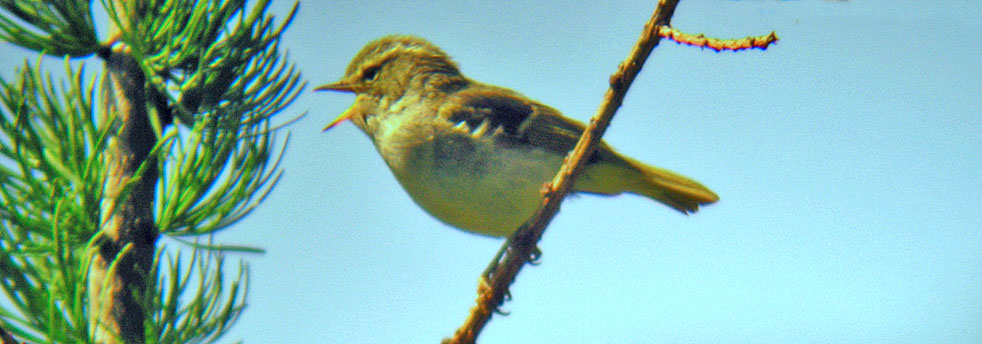 |
The Phylloscopidae is comprised of many tiny tree-loving warblers. Many are canopy or sub-canopy species, gleaning insects from leaves. Many are also rather plain little birds — in muted tones of green, yellow, or brown, with whitish or pale underparts — and identification can be difficult. The family is now called "leaf warblers" and "leaf warbler" is now in the English name of a number of species, except for various "warblers" with long-standing traditional names, and excepting four species of "chiffchaff." Of those, the very widespread species is Common Chiffchaff, bearing a nice onomatopoeic name meant to describe its territorial song.
At least 55 leaf warblers (71% of the current family) are migrants to some extent. Some are elevational migrants in the Himalayas; others fly thousands of miles. Birds that are long-distance migrants are prone to navigational errors that produce vagrants on the other side of the globe. Consider Yellow-browed Warbler (both photos below). In summer it breeds widely across northern Russia, east to Siberia and northeast China, preferring birch, willow, and poplar groves along edges of conifer forests. These breeders move southeast or southwest to winter in southeast Asia (the Yellow-browed captured in mid-jump, below left, was wintering in Thailand). Many vagrants, heading the "wrong" direction, have occurred widely throughout Europe. From 1958–1985, there were 2,648 recorded in Britain and Ireland alone! (Dymond, et al. 1989). All but six were in fall migration, and mostly mid-September to mid-October (see Thorup 1998 on how these vagrants reach Europe).
The first one in North America was in September 1999 on St. Lawrence I., Alaska (Lehman 2000) and a tiny handful more have reached the New World, including the first for California on 24-25 Oct 2019 in remote Alpine Co., east of the Sierran ridge (below right). A very few of us living in Monterey County made it there by its second and final day to enjoy California's most exciting Phylloscopus [there are also a few State record of Arctic Warbler P. borealis and Dusky Warbler P. fuscatus). |
|
 From a birders' perspective, they can be a difficult group to sort through during migration or on wintering grounds. The identification of Phylloscopus warblers — birders tend to call them "Phylloscs" — is the subject of much Palearctic literature. Some of the classic older works are Ticehurst (1938) and Williamson (1976). For a specific problem — such as Radde's versus similar congeners — see Madge (1987) or Leader (1994). For Greenish Warbler, consult Dean (1985) for Pallas's Warbler, read Catley (1992); and so on. There is now British literature, like Lewington et al. (1991) or Beaman & Madge (1998), that cover the identification all the rare vagrant Phylloscs that reach Europe. From a birders' perspective, they can be a difficult group to sort through during migration or on wintering grounds. The identification of Phylloscopus warblers — birders tend to call them "Phylloscs" — is the subject of much Palearctic literature. Some of the classic older works are Ticehurst (1938) and Williamson (1976). For a specific problem — such as Radde's versus similar congeners — see Madge (1987) or Leader (1994). For Greenish Warbler, consult Dean (1985) for Pallas's Warbler, read Catley (1992); and so on. There is now British literature, like Lewington et al. (1991) or Beaman & Madge (1998), that cover the identification all the rare vagrant Phylloscs that reach Europe.
If a birder grew up in Europe, one learned the common and widespread species as the basis for comparison to all other Phylloscs. One such common and widespread species is Willow Warbler (right, shown here on breeding grounds in Norway). It breeds from Britain & Ireland all the way across Eurasia to Siberia. Those breeding populations all migrate to sub-Saharan Africa for the winter. Having a couple of "reference" leaf warblers must surely help search for unfamiliar, and potentially rare, species. An example from western North America, where I live, would be Empidonax flycatchers. Pacific-slope Flycatcher is the basic reference, and Willow Flycatchers come through annually as migrants. So I'm comfortable sorting out the rest with these references. I suspect Old World birders who come here have a more difficult time with these small flycatchers.
Some fame can be earned from finding a new Phylloscopus for a continent [first Yellow-browed Warbler for North America; Lehman 2000], or first for a country [first Yellow-browed Warbler for Mexico; in Baja California, Mlodinow & Radamaker 2007], or first for a state [first Yellow-browed Warbler for California, found by Todd Easterla in Oct 2019].
My claim to fame, such as it is, is taking a Phylloscopus off the list for a continent, country, and state! During research for a book on rarities in western North America (Roberson 1980), I visited the Museum of Vertebrate Zoology at U.C. Berkeley to study North America's only record of Willow Warbler, a specimen taken at Pt. Barrow, Alaska. I noted the anomalous presence of wingbars; brought that problem to ornithologist Frank Pitelka (who had published the specimen initially as "Willow Warbler"); and we then had the specimen re-reviewed. It was an Arctic Warbler P. borealis. We published a paper refuting that lone "record" for North America (Roberson & Pitelka 1983). Since then, however, actual Willow Warblers have been documented in Alaska about 10 times (Howell et al. 2014); the first was in fall 2002 (see Lehman 2003, from Gambell, St. Lawrence I., Alaska). As of the publication of Howell et al. (2014), some six species of vagrant Phylloscopus had been documented in North America, in addition to Alaska's small breeding population of Arctic Warbler.
|
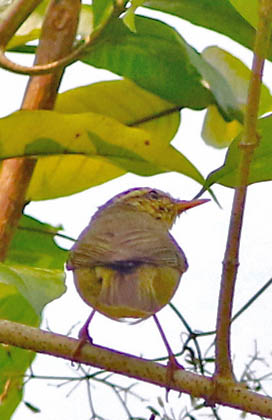 |
Not growing up in the Old World, I don't have a "reference" Phylloscopus. Rather, on trips to the Old World, in winter or migration, I tend to separate Phylloscs into (a) the "eye-browed" species [including Willow Warbler, Chiffchaff, Arctic Warbler & Yellow-browed Warbler] and then further subdivide them between those with and those without wingbars], and (b) the "crowned" species with pale crown stripe, and then try to subdivide those into large one and small ones, and those with or without contrasting rump patches.
In these categories, Blyth's Leaf Warbler (left) is a "eye-browed" species that is green above, white below, with wingbars. It breeds widely in the Himalayas east to south China, and winters from northeast India to Thailand. Lemon-rumped Warbler (right) is a tiny "crowned" species, with a pale yellow rump (hard to see), that is primarily an elevational migrant within the Himalayas. |
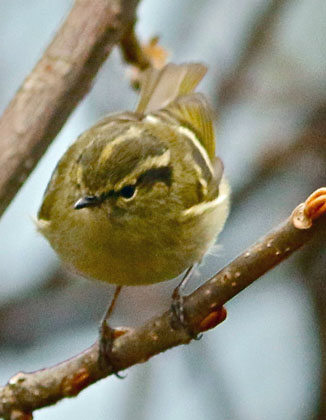 |
|
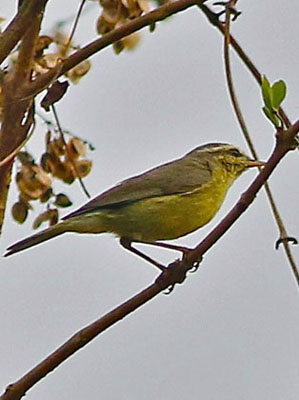 |
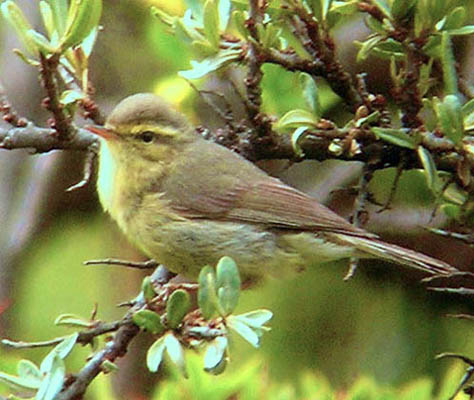 |
One "good" thing from a birders' perspective is that leaf warblers have little variation in summer or winter plumages. Thus Tickell's Warbler (far left) looks much the same in winter as on their breeding grounds in the Himalayas. The nearly identical Alpine Leaf Warbler of montane central China (near left) is a recent split from Tickell's Warbler. |
|
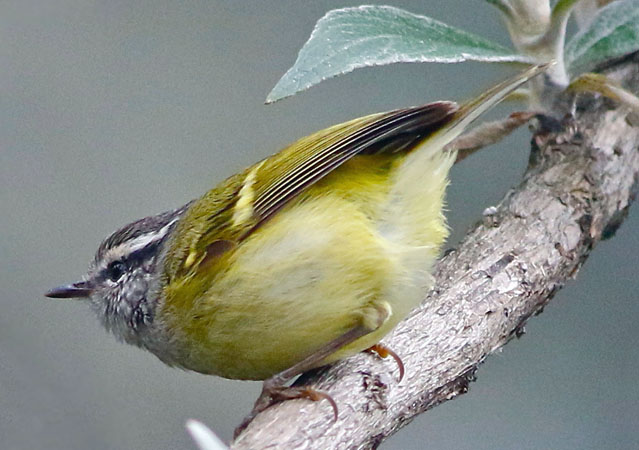 Tickell's Warbler ( above left) is a long-distance migrant. It breeds in scrub at high elevation in the Himalayas and on the Tibetan Plateau and then moves downslope and south to winter in the Himalayan foothills and lowlands of India and Myanmar. In winter it joins mixed species flocks in canopy or sub-canopy. Tickell's Warbler ( above left) is a long-distance migrant. It breeds in scrub at high elevation in the Himalayas and on the Tibetan Plateau and then moves downslope and south to winter in the Himalayan foothills and lowlands of India and Myanmar. In winter it joins mixed species flocks in canopy or sub-canopy.
A very recent split is Alpine Leaf Warbler (above right). Both it and Tickell's Warbler are 'eye-browed' warblers without wingbars, are extensively yellow below, and have a pale lower mandible and legs. Alpine Leaf Warbler breeds in high-altitude ranges in central China (Qinghai, Gansu, Sichuan) and was split due to high genetic divergence and differences in vocalizations (Martens 2010). It is an extremely active little warbler, and I shocked myself in getting the digiscoped image on its breeding grounds. Because it is so similar to Tickell's Warbler, its wintering grounds are essentially unknown.
In contrast to these two migrants, Ashy-throated Warbler (right) is pretty much a resident of the Himalayas from Kashmir to China, and montane forests of southeast Asia. It resides in mixed oak and conifer forests with thick undergrowth, particularly rhododendrons (Bairlein 2006). It is an exceedingly tiny and active leaf warbler, recall in size and behavior Goldcrest (in the Old World) or Golden-crowned Kinglet (in the New World).
The Phylloscopidae are a branch of "Old World Warblers," one of a dozen or more branches that sprouted as Families with the break-up of the traditional Sylviidae [see a discussion of the Break-Up of the Old World Warblers]. Alström et al. (2006) formally proposed the name Phylloscopidae for "clade F" in their biochemical study of the Sylvioidea superfamily. They and others (e.g., Jønsson & Fjeldså 2006, Barker et al. 2004) have shown this is a distinctive lineage. At about the time that Handbook of the Birds of the World reached this lineage (Bairlein 2006), what is today's Phylloscopidae was considered just a subfamily of the giant Sylviidae. That rapidly changed thereafter in three significant ways. First, at that time, 56 species were assigned to genus Phylloscopus, and 12 were assigned to genus Seicercus. But molecular evidence showed that genus Seicercus was embedded within Phylloscopus, and all were merged into today's huge genus Phylloscopus. It is possible that subdivisions may be recognized again in the future. Second, the limits of this group were clarified. For example, both the monotypic genus Tickellia (Broad-billed Warbler) and the 3 species in Abroscopus proved to be members of family Cettiidae. Third, new species continue to be described. One of my headline species — Chinese Leaf-Warbler (above) — is a among several recently described species by Per Alström and colleagues (e.g., Alström et al. 1992, 1997). There is now even a Phylloscopus named for Per Alström — Alström's Warbler Phylloscopus soror — a recent split among the Golden-spectacled Warbler complex (see Alström & Olsson 1999, 2000). |
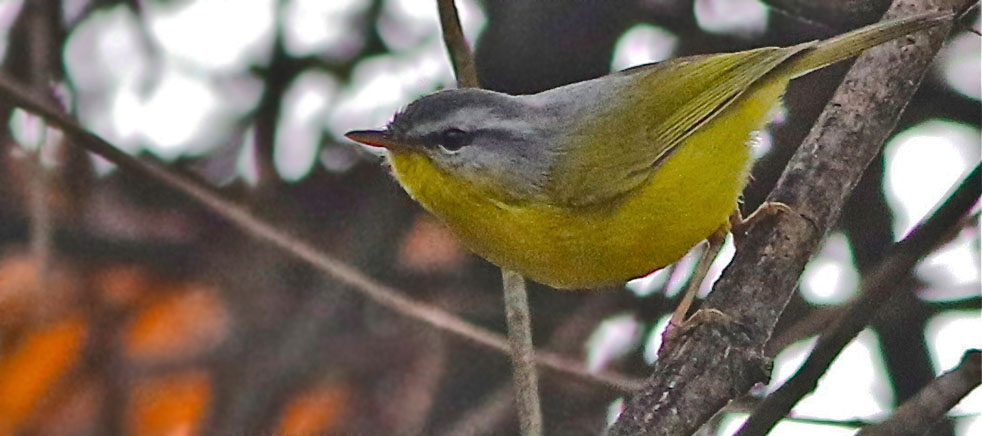 |
Those leaf warblers that had recently been assigned to genus Seicercus were not like all of the other rather plain Phylloscopus. These are a dozen bright, colorful leaf warblers, often with bright yellow underparts, and often showing complex patterns of gray or rufous on the head. Many were resident to some were mid-distance migrants [Alström's Warbler was among those, breeding in central and southeast China and migrating to southeast Asia in winter]. It turns out these were not closely related to each other (Olsson et al. 2004, Martens et al. 2010), but they were quite distinctive from what we had come to expect from a Phylloscopus warbler. I've not seen many in this set, but I did photograph Gray-hooded Warbler (above) in Bhutan. It is essentially a resident of Himalayan foothills and elevations in the subtropical zone, ranging from Pakistan to northeast India and adjacent Myanmar. It forages at mid-levels, eating insects and spiders, and may join mixed species flocks. It comes to the ground only to nest or bathe (Barlein 2006).
In addition to the "Seicercus-like" leaf warblers in south Asia, there is another set of six resident Phylloscopus warblers in montane forests of Africa. Some of those are plain birds but others are colorful, and again break down our concept of how a Phyllosc should look. Speaking of resident species, there are endemic, resident Phylloscopus on tropical islands in the west Pacific, such as Philippine Leaf Warbler P. olivaceus, Sulawesi Leaf Warbler P. serasinorum, and Timor Leaf Warbler P. presbytes. All of these look plain and unremarkable, but vocalizations are often distinctive. |
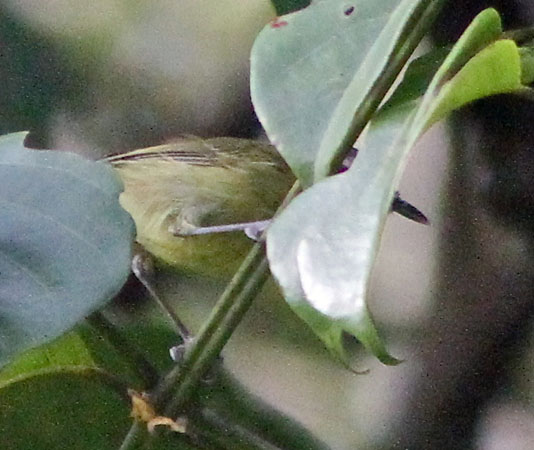 Finally, there are the "dumping ground" leaf warblers: complexes of resident and (mostly) island species that likely involve multiple biological species. One is Mountain Leaf Warbler P. trivirgatus. There is a population on mainland Peninsular Malaysia, and then ten other subspecies scattered across the Greater Sundas and the Philippines, including one restricted to Mt. Kinabalu on Borneo. Some have contrasting crown stripes; others do not. Some are bright yellow below; others are not. Surely there are split to come among this complex. Finally, there are the "dumping ground" leaf warblers: complexes of resident and (mostly) island species that likely involve multiple biological species. One is Mountain Leaf Warbler P. trivirgatus. There is a population on mainland Peninsular Malaysia, and then ten other subspecies scattered across the Greater Sundas and the Philippines, including one restricted to Mt. Kinabalu on Borneo. Some have contrasting crown stripes; others do not. Some are bright yellow below; others are not. Surely there are split to come among this complex.
Even more dramatically in need of study is the complex currently called Island Leaf Warbler P. maforensis (left) with nine "subspecies groups" in eBird/Clements. Isolated populations range from multiple islands in Wallacea, to New Guinea and satellite islands (e.g., populations on Numfor and Biak) and then across the southwestern Pacific. A few are already formally split (e.g., Makira Leaf Warbler P. makirensis on San Cristobal in the Solomon Is.) but a comprehensive review is badly needed.
My photo (left) is of the resident "Island Leaf Warbler" on Halmahera I. in Wallacean Indonesia, currently P. m. henrietta. Our tour group with Rob Hutchinson had discovered a montane forest in a pass above Buli the previous day, on a exploratory effort. When we tried to return early the next morning in taxis, we found that a truck had gotten stuck in one of the detours around bridges that were out. We obtained a 4-wheel drive that got through this obstacle, but had to shuttle the passengers of our second taxi back and forth to the pass. Eventually we were back in this newly-discovered montane forest, where we tried to take photographs and Rob recorded vocalizations for his on-going study of this complex. In my shot the bird is hiding in the foliage but does show a longish bill and legs. This population has a good chance to be a new species sometime in the future, but even the minor obstacles we encountered illustrate part of the difficulty of the work needed.
The current (2020) Phylloscopidae has 77 species and counting. We might expect perhaps 20 more species in the future. In short, the entire family is just a work in progress. |
| |
Photos: The wintering Common Chiffchaff Phylloscopus collybita was flitting through riparian habitat in Mole NP, Ghana, on 13 Dec 2013. The Radde's Warbler Phylloscopus schwarzi was at Khao Yai NP, Thailand, on 25 Dec 2012. The Chinese Leaf Warbler Phylloscopus yunnanensis was singing at the top of a spruce at Wulsingham, Hebei Province, China, in June 2004. The leaping Yellow-browed Warbler Phylloscopus inornatus was at Khao Yai NP, Thailand, on 25 Dec 2012; the first record for California for Yellow-browed Warbler was at Markleeville, Alpine Co., on 25 Oct 2019. The Willow Warbler Phylloscopus trochilus was singing on territory in Oslo, Norway, on 26 June 2013. The Blythe's Leaf Warbler Phylloscopus reguloides was at Nameri NP, Assam, India, on 15 Mar 2019. The Lemon-rumped Warbler Phylloscopus chloronotus was at Chendebji, Bhutan, on 30 Mar 2019. The wintering Tickell's Warbler Phylloscopus affinis was at Nameri NP, Assam, India, on 15 Mar 2019. The summering Alpine Leaf Warbler Phylloscopus occisinensis was on breeding territory in Huzu Bei Shan NP, Qinghai Province, China, on 22 June 2004. The Ashy-throated Warbler Phylloscopus maculipennis was along Lingmethang Rd., Bhutan, on 23 Mar 2019. The Gray-hooded Warbler Phylloscopus xanthoschistos was near Yongkola, Bhutan, on 22 Mar 2019. The half-hidden Island Leaf Warbler Phylloscopus maforensis henrietta was in montane forest above Buli, Halmahera, Indonesia, on 12 Oct 2011.
All photos © Don Roberson; all rights reserved.
Bibliographic note: There is no "family book" per se, but an introduction to this family, with some excellent photos, is in Bairlein (2006). In this account in the Handbook of the Birds of the World, what is now the Phylloscopidae was considered a subfamily (and included multiple genera) in a much larger Sylviidae that also included grassbirds, reed-warblers, bush-warblers, and Sylvia "scrub-warblers."
Literature cited:
Alström, P., U. Olsson, and P.R. Colston. 1992. A new species of Phylloscopus warbler from central China. Ibis 134: 329-334.
Alström, P., U. Olsson, and P.R. Colston. 1997. Re-evaluation of the taxonomic status of Phylloscopus proregulus kansuensis. Bull. Brit. Ornith. Club 117: 177–193.
Alström P., P.G.P. Ericson, U. Olsson, and P. Sundberg. 2006. Phylogeny and classification of the avian superfamily Sylvioidea. Molec. Phylog. Evol. 38: 381–397.
Alström, P., and U. Olsson. 1999. The Golden-spectacled Warbler: a complex of sibling species, including a previously undescribed species. Ibis 141: 545-568.
Alström, P., and U. Olsson. 2000. Golden-spectacled Warbler systematics. Ibis 142: 495–500.
Barker, F.K., A. Cibois, P. Schikler, J. Feinstein, and J. Cracraft. 2004. Phylogeny and diversification of the largest avian radiation. Proc. Nat. Acad. Sci. 101: 11040–11045.
Bairlein, F. 2006. Family Sylviidae (Old World Warblers), pp. 492–709 in Handbook of the Birds of the World (del Hoyo, J., A. Elliott & D.A. Christie, eds). Vol. 11. Lynx Edicions, Barcelona, Spain.
Beaman, M., and S. Madge. 1998. The Handbook of Bird Identification for Europe and the Western Palearctic. Princeton Univ. Press, Princeton, N.J. (published in U.K. by Christopher Helm, London).
Catley, G.P. 1992. Identification pitfalls and assessment problems:. Pallas's Warbler Phylloscopus proregulus. British Birds 85: 491-494.
Cibois, A., E. Pasquet, and T.S. Schulenberg. 1999. Molecular systematics of the Malagasy babblers (Timaliidae) and Warblers (Sylviidae), based on cytochrome b and 16S rRNA sequences. Molec. Phylog. Evol. 3: 581–595.
Dean, A. R. 1985. Review of British status and identification of Greenish Warbler. Brit. Birds 78: 437-451.
Dymond, J.N., P.A. Fraser, and S.J.M. Gantlett. 1989. Rare Birds in Britain and Ireland. 2d ed. T. & A.D. Poyser, Calton, England.
Howell, S.N.G., I. Lewington, and W. Russell. 2014. Rare Birds of North America. Princeton Univ. Press, Princeton, N.J.
Jønsson, K.A., and J. Fjeldså. 2006. A phylogenetic supertree of oscine passerine birds. Zoologica Scripta 35: 149–186.
Leader, P.J. 1994. Field identification of Dusky, Radde’s and Yellow-streaked warblers. Hong Kong Bird Report 1994: 170–180.
Lehman, P.E. 2000. First record of Yellow-browed Warbler (Phylloscopus inornatus) in North America. West. Birds 31: 57–60.
Lehman, P.E. 2003. Gambell, Alaska, autumn 2002: First North American record of Willow Warbler (Phylloscopus trochilus), Lesser Whitethroat (Sylvia curruca), and Spotted Flycatcher (Muscicapa striata). North Amer. Birds 57: 4–11.
Lewington, I., P. Alström, and P. Colston, P. 1991. A Field Guide to the Rare Birds of Britain and Europe. Harper-Collins, London.
Madge, S. C. 1987. Field identification of Radde's and Dusky warblers. Brit. Birds 80: 595–603.
Martens, J. 2010. A preliminary review of the leaf warbler genera Phylloscopus and Seicercus. Brit. Orn. Club Occas. Publ. 5: 41–116.
Mlodinow, S.G., and K. Radamaker. 2007. First record of Yellow-browed Warbler (Phylloscopus inornatus) in Mexico. North Amer. Birds 61: 358–362.
Olsson, U., P. Alström, and P. Sundberg. 2004. Non-monophyly of the avian genus Seicercus (Aves: Sylviidae) revealed by mitochondrial DNA. Zool. Scripta 33: 501-510.
Roberson, D. 1980. Rare Birds of the West Coast. Woodcock Publ., Pacific Grove, CA.
Roberson, D., and F. A. Pitelka. 1983. Occurrence of Willow Warbler (Phylloscopus trochilus) in North America refuted. Condor 85: 258.
Sibley, C.G., and J.E. Ahlquist. 1990. Phylogeny and Classification of Birds: A Study in Molecular Evolution. Yale Univ. Press, New Haven, CT.
Thorup, K. 1998. Vagrancy of Yellow-browed Warbler Phylloscopus inornatus and Pallas’s Warbler P. proregulus in north-west Europe: misorientation on great circles? Ringing & Migration. 19: 7-12.
Ticehurst, C. B. 1938. A Systematic Review of the genus Phylloscopus. British Museum, London.
Williamson, K. 1976. Identification for Ringers: The Genera Phylloscopus. Rev. ed. BTO Identification Guide 2. British Trust for Ornithology.
|
|
|




 The family Phylloscopidae is quite a large family of small, active passerines, split from the giant Sylvioidea assemblage of "Old World Warbler" with the advent of molecular evidence to clarify their evolution and relationships. Most leaf warblers breed at high latitudes in Eurasia and winter in the tropics, including sub-Saharan Africa (Common Chiffchaff in Ghana, above) and southeast Asia (Radde's Warbler in Thailand, left, where this secretive species was skulking in a dense thicket). This is almost entirely an Old World family, but there is a very small breeding population of Arctic Warbler P. borealis in northwest Alaska, but that entire populations flies to Asia for the winter.
The family Phylloscopidae is quite a large family of small, active passerines, split from the giant Sylvioidea assemblage of "Old World Warbler" with the advent of molecular evidence to clarify their evolution and relationships. Most leaf warblers breed at high latitudes in Eurasia and winter in the tropics, including sub-Saharan Africa (Common Chiffchaff in Ghana, above) and southeast Asia (Radde's Warbler in Thailand, left, where this secretive species was skulking in a dense thicket). This is almost entirely an Old World family, but there is a very small breeding population of Arctic Warbler P. borealis in northwest Alaska, but that entire populations flies to Asia for the winter.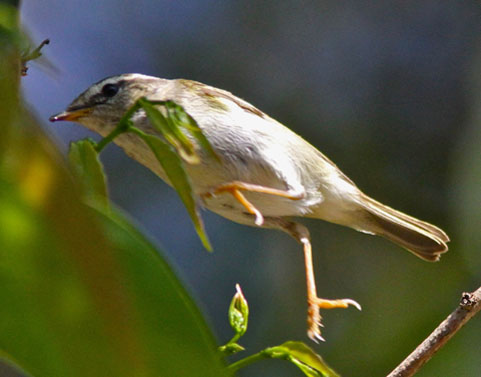

 From a birders' perspective, they can be a difficult group to sort through during migration or on wintering grounds. The identification of Phylloscopus warblers — birders tend to call them "Phylloscs" — is the subject of much Palearctic literature. Some of the classic older works are Ticehurst (1938) and Williamson (1976). For a specific problem — such as Radde's versus similar congeners — see Madge (1987) or Leader (1994). For Greenish Warbler, consult Dean (1985) for Pallas's Warbler, read Catley (1992); and so on. There is now British literature, like Lewington et al. (1991) or Beaman & Madge (1998), that cover the identification all the rare vagrant Phylloscs that reach Europe.
From a birders' perspective, they can be a difficult group to sort through during migration or on wintering grounds. The identification of Phylloscopus warblers — birders tend to call them "Phylloscs" — is the subject of much Palearctic literature. Some of the classic older works are Ticehurst (1938) and Williamson (1976). For a specific problem — such as Radde's versus similar congeners — see Madge (1987) or Leader (1994). For Greenish Warbler, consult Dean (1985) for Pallas's Warbler, read Catley (1992); and so on. There is now British literature, like Lewington et al. (1991) or Beaman & Madge (1998), that cover the identification all the rare vagrant Phylloscs that reach Europe.



 Tickell's Warbler ( above left) is a long-distance migrant. It breeds in scrub at high elevation in the Himalayas and on the Tibetan Plateau and then moves downslope and south to winter in the Himalayan foothills and lowlands of India and Myanmar. In winter it joins mixed species flocks in canopy or sub-canopy.
Tickell's Warbler ( above left) is a long-distance migrant. It breeds in scrub at high elevation in the Himalayas and on the Tibetan Plateau and then moves downslope and south to winter in the Himalayan foothills and lowlands of India and Myanmar. In winter it joins mixed species flocks in canopy or sub-canopy. Finally, there are the "dumping ground" leaf warblers: complexes of resident and (mostly) island species that likely involve multiple biological species. One is Mountain Leaf Warbler P. trivirgatus. There is a population on mainland Peninsular Malaysia, and then ten other subspecies scattered across the Greater Sundas and the Philippines, including one restricted to Mt. Kinabalu on Borneo. Some have contrasting crown stripes; others do not. Some are bright yellow below; others are not. Surely there are split to come among this complex.
Finally, there are the "dumping ground" leaf warblers: complexes of resident and (mostly) island species that likely involve multiple biological species. One is Mountain Leaf Warbler P. trivirgatus. There is a population on mainland Peninsular Malaysia, and then ten other subspecies scattered across the Greater Sundas and the Philippines, including one restricted to Mt. Kinabalu on Borneo. Some have contrasting crown stripes; others do not. Some are bright yellow below; others are not. Surely there are split to come among this complex.